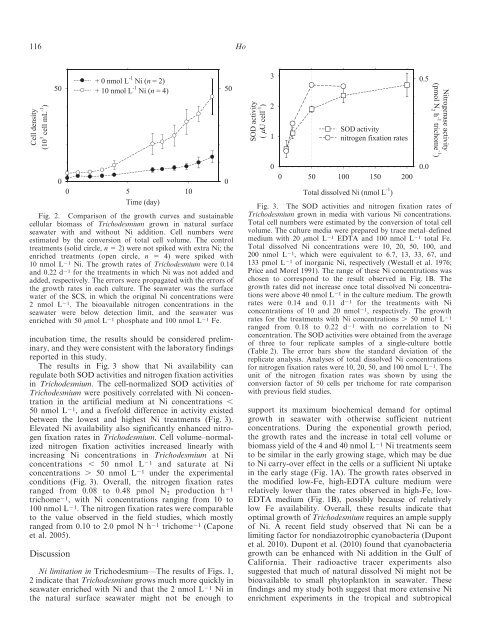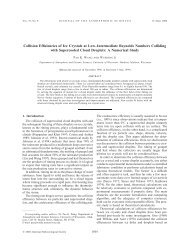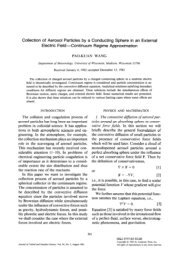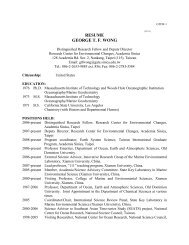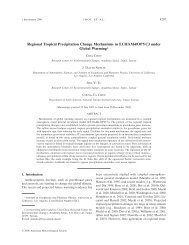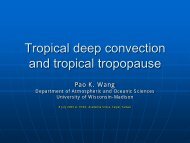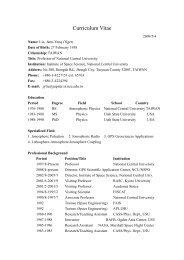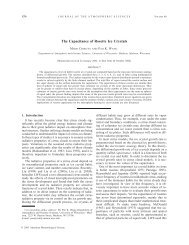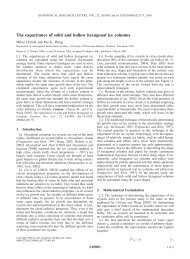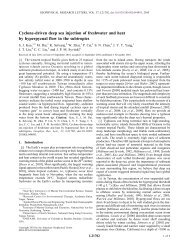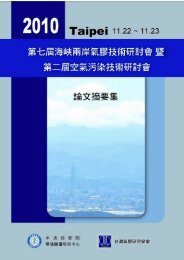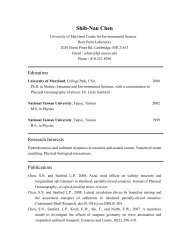Ho, Tung-Yuan. Nickel limitation of nitrogen ... - Academia Sinica
Ho, Tung-Yuan. Nickel limitation of nitrogen ... - Academia Sinica
Ho, Tung-Yuan. Nickel limitation of nitrogen ... - Academia Sinica
- No tags were found...
You also want an ePaper? Increase the reach of your titles
YUMPU automatically turns print PDFs into web optimized ePapers that Google loves.
116 <strong>Ho</strong>Fig. 2. Comparison <strong>of</strong> the growth curves and sustainablecellular biomass <strong>of</strong> Trichodesmium grown in natural surfaceseawater with and without Ni addition. Cell numbers wereestimated by the conversion <strong>of</strong> total cell volume. The controltreatments (solid circle, n 5 2) were not spiked with extra Ni; theenriched treatments (open circle, n 5 4) were spiked with10 nmol L 21 Ni. The growth rates <strong>of</strong> Trichodesmium were 0.14and 0.22 d 21 for the treatments in which Ni was not added andadded, respectively. The errors were propagated with the errors <strong>of</strong>the growth rates in each culture. The seawater was the surfacewater <strong>of</strong> the SCS, in which the original Ni concentrations were2 nmol L 21 . The bioavailable <strong>nitrogen</strong> concentrations in theseawater were below detection limit, and the seawater wasenriched with 50 mmol L 21 phosphate and 100 nmol L 21 Fe.incubation time, the results should be considered preliminary,and they were consistent with the laboratory findingsreported in this study.The results in Fig. 3 show that Ni availability canregulate both SOD activities and <strong>nitrogen</strong> fixation activitiesin Trichodesmium. The cell-normalized SOD activities <strong>of</strong>Trichodesmium were positively correlated with Ni concentrationin the artificial medium at Ni concentrations ,50 nmol L 21 , and a fivefold difference in activity existedbetween the lowest and highest Ni treatments (Fig. 3).Elevated Ni availability also significantly enhanced <strong>nitrogen</strong>fixation rates in Trichodesmium. Cell volume–normalized<strong>nitrogen</strong> fixation activities increased linearly withincreasing Ni concentrations in Trichodesmium at Niconcentrations , 50 nmol L 21 and saturate at Niconcentrations . 50 nmol L 21 under the experimentalconditions (Fig. 3). Overall, the <strong>nitrogen</strong> fixation ratesranged from 0.08 to 0.48 pmol N 2 production h 21trichome 21 , with Ni concentrations ranging from 10 to100 nmol L 21 . The <strong>nitrogen</strong> fixation rates were comparableto the value observed in the field studies, which mostlyranged from 0.10 to 2.0 pmol N h 21 trichome 21 (Caponeet al. 2005).DiscussionNi <strong>limitation</strong> in Trichodesmium—The results <strong>of</strong> Figs. 1,2 indicate that Trichodesmium grows much more quickly inseawater enriched with Ni and that the 2 nmol L 21 Ni inthe natural surface seawater might not be enough toFig. 3. The SOD activities and <strong>nitrogen</strong> fixation rates <strong>of</strong>Trichodesmium grown in media with various Ni concentrations.Total cell numbers were estimated by the conversion <strong>of</strong> total cellvolume. The culture media were prepared by trace metal–definedmedium with 20 mmol L 21 EDTA and 100 nmol L 21 total Fe.Total dissolved Ni concentrations were 10, 20, 50, 100, and200 nmol L 21 , which were equivalent to 6.7, 13, 33, 67, and133 pmol L 21 <strong>of</strong> inorganic Ni, respectively (Westall et al. 1976;Price and Morel 1991). The range <strong>of</strong> these Ni concentrations waschosen to correspond to the result observed in Fig. 1B. Thegrowth rates did not increase once total dissolved Ni concentrationswere above 40 nmol L 21 in the culture medium. The growthrates were 0.14 and 0.11 d 21 for the treatments with Niconcentrations <strong>of</strong> 10 and 20 nmol 21 , respectively. The growthrates for the treatments with Ni concentrations . 50 nmol L 21ranged from 0.18 to 0.22 d 21 with no correlation to Niconcentration. The SOD activities were obtained from the average<strong>of</strong> three to four replicate samples <strong>of</strong> a single-culture bottle(Table 2). The error bars show the standard deviation <strong>of</strong> thereplicate analysis. Analyses <strong>of</strong> total dissolved Ni concentrationsfor <strong>nitrogen</strong> fixation rates were 10, 20, 50, and 100 nmol L 21 . Theunit <strong>of</strong> the <strong>nitrogen</strong> fixation rates was shown by using theconversion factor <strong>of</strong> 50 cells per trichome for rate comparisonwith previous field studies.support its maximum biochemical demand for optimalgrowth in seawater with otherwise sufficient nutrientconcentrations. During the exponential growth period,the growth rates and the increase in total cell volume orbiomass yield <strong>of</strong> the 4 and 40 nmol L 21 Ni treatments seemto be similar in the early growing stage, which may be dueto Ni carry-over effect in the cells or a sufficient Ni uptakein the early stage (Fig. 1A). The growth rates observed inthe modified low-Fe, high-EDTA culture medium wererelatively lower than the rates observed in high-Fe, low-EDTA medium (Fig. 1B), possibly because <strong>of</strong> relativelylow Fe availability. Overall, these results indicate thatoptimal growth <strong>of</strong> Trichodesmium requires an ample supply<strong>of</strong> Ni. A recent field study observed that Ni can be alimiting factor for nondiazotrophic cyanobacteria (Dupontet al. 2010). Dupont et al. (2010) found that cyanobacteriagrowth can be enhanced with Ni addition in the Gulf <strong>of</strong>California. Their radioactive tracer experiments alsosuggested that much <strong>of</strong> natural dissolved Ni might not bebioavailable to small phytoplankton in seawater. Thesefindings and my study both suggest that more extensive Nienrichment experiments in the tropical and subtropical


